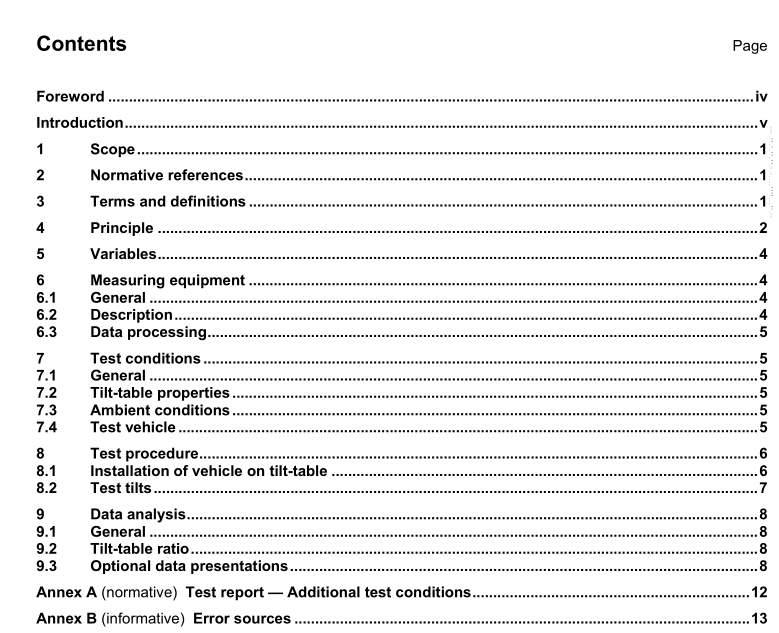ISO 16333 pdf download

ISO 16333 pdf download Heavy commercial vehicles and buses — Steady-state rollover threshold — Tilt- table test method
7.4.2 Self-regulating suspensions
For the standard test condition, if the test vehicle is equipped with height- or load-regulating suspensions, suspension ride height or load shall be appropriately established before testing begins, and the active adjustment function of the suspension shall be disabled during testing. Optionally, in some cases, e.g. when the regulating system has a relatively fast response, it may be appropriate to allow self-regulation functions to remain active during the tilt test. In either case, the state of the self-regulation shall be reported. Annex B includes discussion on disabling self-regulating suspension features. For height-regulating suspensions, reliable means shall be provided to identify the proper ride height within ± 5 mm during manual inflation. For load-regulating suspensions, reliable means shall be provided to identify the proper inflation pressure within ± 5 % or ± 10 kPa, whichever is greater, during manual inflation.
8 Test procedure
8.1 Installation of vehicle on tilt-table
8.1.1 Alignment For the standard test condition, the X-v-axis of each vehicle unit shall be parallel to the table pivot axis within ± 50 mm at each axle and, when applicable, at the coupling joints.
8.1.2 Lateral constraint For the standard test condition, the surface of the tilt-table shall be such that tyre friction is adequate to preclude the vehicle sliding sideways at the critical tilt angle. Additional safety restraints should be used to arrest lateral motion in the event that the vehicle were to slide sideways on the table surface. Optionally, a trip rail of any height up to the specified maximum may be provided immediately adjacent to the low-side tyre of each axle such as to prevent the vehicle from sliding sideways at high tilt angles. The maximum height of the trip rail shall be either 60 mm or two-thirds of the height between the wheel rim and the tilt-table, whichever is larger. If a trip rail is used, the geometry of the trip rail shall be recorded. NOTE 1 Table surfaces that achieve friction coefficients approaching unity are available. See Annex B. NOTE 2 The use of trip rails can be expected to influence the result of the test by increasing TTR slightly. See Annex B.
8.1.3 Longitudinal constraint Longitudinal constraint of the vehicle shall be accomplished by constraints applied at one, and only one, axle. When applicable, the transmission shall be in neutral and differential locks shall not be applied. The proper response of heavy vehicle suspensions during tilt tests typically requires small, but free longitudinal motion of the axles. When individual axle tables are used, care should be taken that such motion can safely take place on the surfaces of the tables. If longitudinal constraint is provided by blocking tyres of a steering axle, the steering system should be locked appropriately. In any case, it is also recommended that additional safety constraints be used, such as slack, longitudinal cables or chains applied to one or more axles near the low-side tyres.
8.1.4 Roll restraints Safety restraints shall be provided that are capable of fully arresting the roll motion of the test vehicle immediately after critical wheel lift occurs.
8.1.5 Auxiliary vertical support
Some test vehicles require auxiliary vertical support at the coupling joint. For example, a semitrailer coupled to a converter dolly requires support of the dolly drawbar at the pintle hitch. In such cases, a mechanism shall be provided that
a) provides the necessary vertical support in a manner representative of normal use,
b) maintains lateral position according to 8.1.1, and
c) provides no significant roll coupling at the support point.
8.1.6 Suspension condition
8.1.6.1 Neutral roll condition
It is recommended that, prior to each test, each suspension of the test vehicle be placed in a nominally neutral roll condition (i.e. with respect to hysteresis resulting from Coulomb friction). Means to do this may include, but are not limited to, the following.
⎯ Reinstall the vehicle on the table prior to each test.









